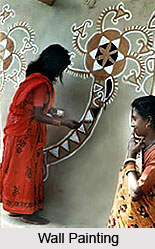 Handicrafts of Hazaribagh are quite exquisite and are highly applauded by all the tourists and visitors. The art of mural painting is a tradition of the matriarchal society and also a sacred convention of the matriarchal native system. The way this handicraft of Hazaribagh is prepared by all the married women during the harvesting and wedding ceremonies. The married women are called Devi. The young woman learns this handicraft of Hazaribagh from their near and dear ones like their aunts and their mothers.
Khovar also is one of the important handicrafts of Hazaribagh. This is an example of wedding. Etymologically, Khovar has been named after nuptial room and bridegroom. Its origination dates back to the cave dwelling of the predecessors. These multicolored caves are found in building complexes of Vindhyan, Mirzapur, and Jharkhand , popularly called Khobar. The word Kho means caves , while var stands for bridegroom. Various forms of plants , symbols related to fertility which are linked to `Calcolithic mandalas` in the rock art are engraved here. Other symbols like forms of wild animals, which were found in the rockarts of Mesolithic period, also are traced down.
Handicrafts of Hazaribagh are quite exquisite and are highly applauded by all the tourists and visitors. The art of mural painting is a tradition of the matriarchal society and also a sacred convention of the matriarchal native system. The way this handicraft of Hazaribagh is prepared by all the married women during the harvesting and wedding ceremonies. The married women are called Devi. The young woman learns this handicraft of Hazaribagh from their near and dear ones like their aunts and their mothers.
Khovar also is one of the important handicrafts of Hazaribagh. This is an example of wedding. Etymologically, Khovar has been named after nuptial room and bridegroom. Its origination dates back to the cave dwelling of the predecessors. These multicolored caves are found in building complexes of Vindhyan, Mirzapur, and Jharkhand , popularly called Khobar. The word Kho means caves , while var stands for bridegroom. Various forms of plants , symbols related to fertility which are linked to `Calcolithic mandalas` in the rock art are engraved here. Other symbols like forms of wild animals, which were found in the rockarts of Mesolithic period, also are traced down.
Tattooing also forms an integral part of the handicrafts of Hazaribagh. All the women folks of Malhar tribal community made beautiful tattoos, better known as Godna. They have adapted the profession of metal casting. Their motives are found in the primitive rock art forms. It is the tradition of both matriarchy and also shamanism. Apart from this, these metal casters also practices a sanctified art in casting metals. It is also a Chalcolithic convention. Exclusive is the walls which are beautified with colors and paints. They are done so for welcoming the bridegroom who is compared to deity Indra boarding on an elephant. Exquisite symbols of wild animals of forest areas and also plant forms symbolizing fertility form the part of the wall décor.
One of the significant handicrafts of Hazaribagh is Sohrai . It is type of harvesting art. It also has an etymological significance. In fact the word is a derivation from Soroi , a Mundaric word which means `to whip, or beat`, indicating its relation to cattle. Originally Soroi has its root in Soro, which signifies `to close the door`, thereby emphasizing the fact of first tameness of cattle in a Mundaric community. This art form is derived from rock art form in which a famous sign of West Asia and Indus Valley is tracked down. It is called Tree of Life which can be traced to Saraiya, rock art form of the pre - Mesolithic period. It is done to welcome cattle, which are being taken to the forests on the morning of festive day and again being brought in over the aripans. Aripans are the motifs done with rice gruel by the married women in the similar manner as is done in the rock art forms of Khandar. This welcome aripan is drawn in the form of cattle hoves, which is similar to the rockart.



















